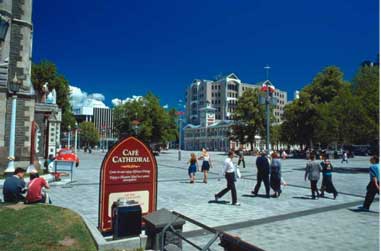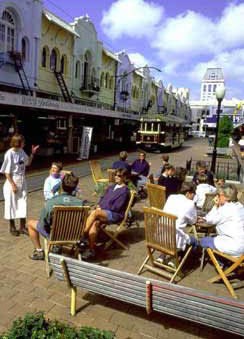| Our Environment: Issue 24 Spring 2000 |
 A
river promenade along the Avon, more tree-lined streets and distinctive communities are
among ideas suggested to revive the Central City. The ideas are included in a City Council
document aimed at stimulating discussion leading to the development of a Central City
strategy. This follows
a major push by Mayor Garry Moore and the Christchurch City Council to revitalise the
heart of our City.
A
river promenade along the Avon, more tree-lined streets and distinctive communities are
among ideas suggested to revive the Central City. The ideas are included in a City Council
document aimed at stimulating discussion leading to the development of a Central City
strategy. This follows
a major push by Mayor Garry Moore and the Christchurch City Council to revitalise the
heart of our City.
A Central City Mayoral Forum has been meeting regularly to generate ideas and, along with a proposed Central City Board, will spearhead the campaign. Both need a clear direction for the future of the Central City. Initial feedback from the City Scene in August suggests many people would like to see a more interesting Central City area with more people living and playing there. They want more activites including cultural events, a greater range of shopping and commercial opportunities, more attractive and accessible streets, and a safer place to be at night.
The latest residents’ survey commissioned by the City Council revealed that 61 per cent of people feel unsafe after dark in the Central City. Noise complaints have increased 170 per cent since 1991 and the volume of traffic continues to increase steadily. Infill development has prompted concerns about lack of privacy, building heights and loss of trees and gardens. At the same time residents who made non-work trips into the Central City increased by 72 per cent between 1991 and 1999. Sixty five per cent of people who visited the heart of Christchurch were satisfied or very satisfied with what the area offered, according to this year’s survey of residents. One of the largest commercial areas in New Zealand, the Central City provides opportunities for improving use of existing commercial areas and greater centralisation. Project manager Dr Mark Bachels says the Central City strategy is intended to link Council activities and private development opportunities, provide incentives and reduce barriers to revitalisation. Most importantly, it will establish direction, leadership and vision for priority projects over the next 25 years.
But first the Council needs Christchurch people to say what they would like to see in the Central City. One idea is for more activities, improvements and attractions along the Avon River. The document points out that the concept of an extended river promenade has been successfully introduced in a number of Cities to provide distinct attractions and sites along the river to visit, socialise, eat and generally spend time.
The discussion document also identifies 10 neighbourhoods or precincts in the Central City: Victoria, St Mary’s, Avon, Worcestor, Merchant, Latimer, Oxford, South, High and East. It aims to stimulate thinking about how we can create more recognisable communities and diversity within the Central City by developing specific themes or projects.
Most of the City’s recent success stories such as Worcester Boulevard and the Arts Centre, Victoria Square and The “Strip” have been in the Central City west of Colombo Street. The discussion document asks whether areas east of Colombo Street should be given higher priority for revitalisation. Pleasant streets are critical for a healthy Central City. Comprising about 40 per cent of our public space, streets provide tremendous scope for improvements, says Dr Bachels.
 Suggestions so far include more public art, wider footpaths, better street
lighting, more trees and improved crossing points. The document seeks feedback on how
pedestrian linkages could be improved within the Central City. More specifically, it also
wants to know whether people support significantly more tree planting on some Central City
streets. It also seeks ideas on transport and parking improvements. It
points out that the Central City has the highest concentration of commercial, civic and
public heritage buildings in Christchurch. These buildings contribute to the City’s
unique character and give it a special sense of “place”.
Suggestions so far include more public art, wider footpaths, better street
lighting, more trees and improved crossing points. The document seeks feedback on how
pedestrian linkages could be improved within the Central City. More specifically, it also
wants to know whether people support significantly more tree planting on some Central City
streets. It also seeks ideas on transport and parking improvements. It
points out that the Central City has the highest concentration of commercial, civic and
public heritage buildings in Christchurch. These buildings contribute to the City’s
unique character and give it a special sense of “place”.
The discussion document asks what relevance our built heritage has as the City grows and changes to meet current and future needs? If we want to retain our heritage buildings how can we make the best use of them and what incentives might be pursued for reusing them in the next 30 years? It also asks private developers and land owners what barriers currently exist to project development in our Central City and what incentives or opportunities should be explored to enhance private development? The Mayor and Central City Forum plan to discuss ideas with members of the community at meetings and workshops over the next few months and analyse written submissions.
You can send in your ideas to Mark Bachels, Project Manager, Central City Revitalisation, at the City Council Offices.
Jennie Hamilton
| Our Environment Index |